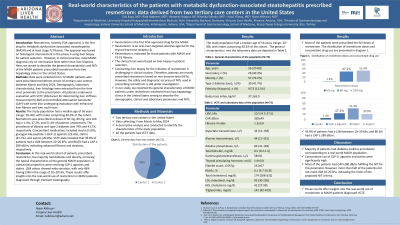Tuesday Poster Session
Category: Liver
P4645 - Real-World Characteristics of the Patients With Metabolic Dysfunction-Associated Steatohepatitis Prescribed Resmetirom: Data Derived From Two Tertiary Care Centers in the United States
Tuesday, October 29, 2024
10:30 AM - 4:00 PM ET
Location: Exhibit Hall E

Has Audio
- NA
Naim Alkhouri, MD
Arizona Liver Health
Chandler, AZ
Presenting Author(s)
Eda Kaya, 1, Rida Nadeem, MD2, Himanshi Kapoor, BS2, Niharika Samala, MD3, Yusuf Yilmaz, MD4, Naim Alkhouri, MD2
1Knappschaftskrankenhaus Bochum, Bochum, Nordrhein-Westfalen, Germany; 2Arizona Liver Health, Chandler, AZ; 3Indiana University School of Medicine, Indianapolis, IN; 4Recept Tayyip Erdogan University, Rize, Rize, Turkey
Introduction: Resmetirom, recently FDA-approved, is the first drug for metabolic dysfunction-associated steatohepatitis (MASH) and at least stage F2 fibrosis. The approval was based on histological improvement in the phase 3 using liver biopsy for patient selection. However, in clinical practice, most MASH diagnosis rely on noninvasive tests rather than liver biopsies. Here, we aimed to describe the general characteristics and NITs of the MASH patients prescribed resmetirom from two hepatology clinics in the United States.
Methods: Data were collected from 72 MASH patients who were prescribed resimetrom at two US tertiary care centers between March and May 2024. Demographic, laboratory characteristics, liver histology were extracted from the time most proximate to the prescription. All patients underwent evaluation with Fibroscan for determining liver stiffness measurement (LSM) and controlled attenuation parameter (CAP) with some also undergoing evaluation with enhanced liver fibrosis and liver multiscan.
Results: The study population had a median age of 56 years (range: 20–80), with males comprising 40.3% of the cohort. Resmetirom was prescribed at doses of 60 mg, 80 mg, and 100 mg in 1.4%, 47.2%, and 51.4% of patients, respectively. The prevalence of obesity and type 2 diabetes was 79% and 41.7%, respectively. Concomitant medications included insulin (5.6%), glucagon-like peptide-1 (GLP-1) agonists (23.6%), statins (41.7%), and aspirin (20.8%). Fibroscan data revealed that 45.8% of patients had a LSM between 10–20 kPa, and 80.6% had a CAP ≥ 280 dB/m, indicating advanced fibrosis and steatosis, respectively. Historical biopsy suppoting on lable prescription was available in 68%.
Discussion: In this real-world cohort of patients prescribed resmetirom, the majority had diabetes and obesity, mirroring the typical characteristics of the general MASH population. A substantial proportion were receiving GLP-1 agonists and statins. LSM values showed wide variation, with only 46% having LSM in the range of 10–20 kPa. These results offer insights into the real-world use of resmetirom in MASH patients diagnosed through transient elastography.
Note: The table for this abstract can be viewed in the ePoster Gallery section of the ACG 2024 ePoster Site or in The American Journal of Gastroenterology's abstract supplement issue, both of which will be available starting October 27, 2024.
Disclosures:
Eda Kaya, 1, Rida Nadeem, MD2, Himanshi Kapoor, BS2, Niharika Samala, MD3, Yusuf Yilmaz, MD4, Naim Alkhouri, MD2. P4645 - Real-World Characteristics of the Patients With Metabolic Dysfunction-Associated Steatohepatitis Prescribed Resmetirom: Data Derived From Two Tertiary Care Centers in the United States, ACG 2024 Annual Scientific Meeting Abstracts. Philadelphia, PA: American College of Gastroenterology.
1Knappschaftskrankenhaus Bochum, Bochum, Nordrhein-Westfalen, Germany; 2Arizona Liver Health, Chandler, AZ; 3Indiana University School of Medicine, Indianapolis, IN; 4Recept Tayyip Erdogan University, Rize, Rize, Turkey
Introduction: Resmetirom, recently FDA-approved, is the first drug for metabolic dysfunction-associated steatohepatitis (MASH) and at least stage F2 fibrosis. The approval was based on histological improvement in the phase 3 using liver biopsy for patient selection. However, in clinical practice, most MASH diagnosis rely on noninvasive tests rather than liver biopsies. Here, we aimed to describe the general characteristics and NITs of the MASH patients prescribed resmetirom from two hepatology clinics in the United States.
Methods: Data were collected from 72 MASH patients who were prescribed resimetrom at two US tertiary care centers between March and May 2024. Demographic, laboratory characteristics, liver histology were extracted from the time most proximate to the prescription. All patients underwent evaluation with Fibroscan for determining liver stiffness measurement (LSM) and controlled attenuation parameter (CAP) with some also undergoing evaluation with enhanced liver fibrosis and liver multiscan.
Results: The study population had a median age of 56 years (range: 20–80), with males comprising 40.3% of the cohort. Resmetirom was prescribed at doses of 60 mg, 80 mg, and 100 mg in 1.4%, 47.2%, and 51.4% of patients, respectively. The prevalence of obesity and type 2 diabetes was 79% and 41.7%, respectively. Concomitant medications included insulin (5.6%), glucagon-like peptide-1 (GLP-1) agonists (23.6%), statins (41.7%), and aspirin (20.8%). Fibroscan data revealed that 45.8% of patients had a LSM between 10–20 kPa, and 80.6% had a CAP ≥ 280 dB/m, indicating advanced fibrosis and steatosis, respectively. Historical biopsy suppoting on lable prescription was available in 68%.
Discussion: In this real-world cohort of patients prescribed resmetirom, the majority had diabetes and obesity, mirroring the typical characteristics of the general MASH population. A substantial proportion were receiving GLP-1 agonists and statins. LSM values showed wide variation, with only 46% having LSM in the range of 10–20 kPa. These results offer insights into the real-world use of resmetirom in MASH patients diagnosed through transient elastography.
Note: The table for this abstract can be viewed in the ePoster Gallery section of the ACG 2024 ePoster Site or in The American Journal of Gastroenterology's abstract supplement issue, both of which will be available starting October 27, 2024.
Disclosures:
Eda Kaya indicated no relevant financial relationships.
Rida Nadeem indicated no relevant financial relationships.
Himanshi Kapoor indicated no relevant financial relationships.
Niharika Samala: Novo Nordisk – Consultant.
Yusuf Yilmaz: Novo Nordisk – Advisory Committee/Board Member, Consultant. Zydus – Advisory Committee/Board Member, Consultant.
Naim Alkhouri: Altimmune, Chronwell ,Cytodyne,Madrigal Pharmaceuticals,Merck,Novo Nordisk,Rivus,Takeda,Terns – Consultant, Grant/Research Support.
Eda Kaya, 1, Rida Nadeem, MD2, Himanshi Kapoor, BS2, Niharika Samala, MD3, Yusuf Yilmaz, MD4, Naim Alkhouri, MD2. P4645 - Real-World Characteristics of the Patients With Metabolic Dysfunction-Associated Steatohepatitis Prescribed Resmetirom: Data Derived From Two Tertiary Care Centers in the United States, ACG 2024 Annual Scientific Meeting Abstracts. Philadelphia, PA: American College of Gastroenterology.
